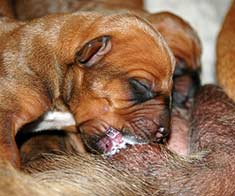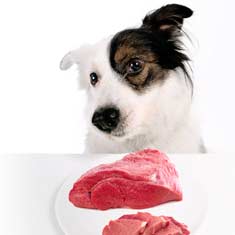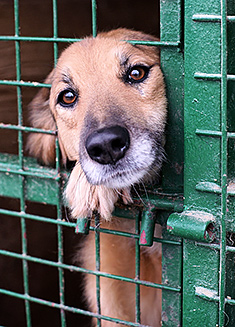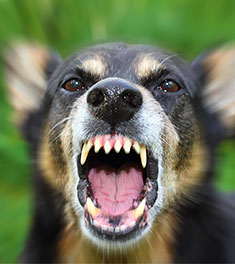Canine Cancer - Part Two: Most Common Cancers in Dogs
This article is the second in a series about cancer in dogs and will review the symptoms, treatment, and prognosis of the most common types of cancer. Future articles in this series will review the basics of chemotherapy and home treatment for a terminally-ill dog.
According to the National Canine Cancer Foundation (link to http://www.wearethecure.org/), cancer affects one out of every three dogs. Of those aflicted, over half will die of cancer. Although benign tumors far outnumber malignancies, this article will deal with only the most common types of malignant cancers: lymphoma, osteosarcoma, anal sac adenocarcinomas, mast cell sarcomas, and breast cancer.
Lymphoma in Dogs
Lymphoma, also known as lymphosarcoma, is a cancer that attacks the lymph system of the dog. Depending on where it strikes, it may be classified as external (involving the lymph nodes just under the surface of the skin), gastrointestinal (involving the lymph system around the digestive system), mediastinal (involving the lymph system around the heart and lungs), cutaneous (involving the skin), and leukemia (involving the bone marrow).
The various types cause different symptoms, as you might expect. When only external lymph nodes are involved, the dog may not appear to be very sick. You will feel lumps under his skin, but he may exhibit no symptoms other than being tired or not interested in his food.
As the disease progresses, the tumors will likely spread to other areas, and your dog will begin to show the symptoms for each of the other types. Gastrointestinal involvement causes vomiting, diarrhea, and weight loss, while mediastinal tumors can cause difficulty breathing. A dog with cutaneous lymphoma will have flaky, scaly, itchy skin with lumps that can ulcerate or break open. Cutaneous lymphoma may also effect the gums and footpads. Leukemia generally presents with general symptoms like tiredness; diagnosis requires a blood test to count the number of circulating red blood cells and white blood cells, which are made in the bone marrow.
The best treatment for lymphosarcoma is chemotherapy, which will cause about 80% of dogs to go into remission. Dogs react to chemotherapy with much fewer problems than humans do. Only about 5 - 10% of treated dogs experience nausea, vomiting, loss of appetite, extreme tiredness, hair loss, or infection. Your dog will generally have a very good quality of life during chemotherapy, however, the average survival time is only about 1 year. Without treatment, survival is measured in weeks.
Osteosarcome
Osteosarcoma is the most common form of bone cancer. Although it can occur in the ribs, skull, vertebrae, and pelvis, osteosarcoma is most common in the limbs of large and giant dogs. Tumors are most common at the growth plates, located in the joints of the legs. If your dog develops osteosarcoma, you will likely notice lameness, pain, and a firm swelling in one of the dog's legs. He may also become irritable, aggressive, and unable to sleep or may lose his appetite and whimper or cry a lot.
If the tumor occurs in a limb, the most common treatment is surgical removal of the leg. This not only removes the tumor, it improves the dog's quality of life because it stops the pain. However, by the time bone cancer is diagnosed, it has frequently spread to other organs, most commonly the lungs, so chemotherapy is recommended. With surgery alone, a dog will generally live 4 - 6 months, but with chemotherapy in addition to the surgery, average survival time is extended to 1 year.
When tumors occur in places other than the limbs (known as the axial skeleton), complete surgical removal of the tumor may not be possible. In this case, follow-up treatment generally includes radiation to control tumor regrowth. If the tumor spreads to other organs, chemotherapy may be used as well. Regardless of treatment, the dog may be expected to live only 4 - 6 months, although his quality of life will be better with treatment than without.
Anal Sac Adenocarcinoma
On each side of your dog's rectum, there are apocrine glands which release a small amount of liquid with a scent individual to each dog. These glands form the basis of the butt-sniffing greeting we always wonder about. When a nose is pressed against the anal glands, a small amount of the dog's scent is released, by which other dogs learn to identify him. Most dogs empty their anal sacs when they have a bowel movement, but sacs can become clogged, causing the dog to scoot around on your carpet to try to relieve the pressure.
Female dogs, as well as male dogs who are unnneutered often develop tumors in these glands. When a tumor develops, you may be able to see the enlarged anal sac, or your dog may have trouble with bowel movements. Your dog may also begin scooting as he would if the sacs were full, but the behavior will continue longer than normal.
Anal sac tumors are extremely aggressive and often travel forward into the lymph system, causing secondary lymphosarcoma. Surgery is possible to remove the tumors, both in the anal sacs and in the lymph system, but it is rarely curative. Radiation therapy and chemotherapy may also be used to control recurrence. However, most dogs die in about 9 months, even if they are treated.
Mast Cell Sarcomas
Also known as mastocytomas, these very common tumors can appear anywhere on or in your dog's body. The most common sites are on the back legs and on the tummy. Mastocytomas can occur in any kind of dog, but it seems that some breeds are predisposed, including Boxers, Pugs, Rhodesian Ridgebacks, and Boston Terriers.
Mast cells normally occur in the skin, intestines and respiratory tract. Their function is to produce enzymes that break down proteins to aid in digestion. They also produce heparin which prevents blood clots, and histamine that is important in the immune system. When a tumor ruptures, which is common, the cells release large amounts of proteolytic enzymes, heparin, and histamine, which can cause additional problems for your dog.
When you feel lumps in your dog's skin, you most often are feeling fatty tumors, which are totally harmless. However, mast cell tumors can feel exactly like fatty tumors, so any new lumps should be checked out by your vet. He will likely use a skinny needle to take a biopsy of the cells in the lump in order to make a diagnosis.
For tumors caught early, i.e. before they metastasize to other areas, surgery is generally the recommended treatment. Sometimes radiation and hyperthermia (heating the area of the tumor) will be used after surgery. If the lymph nodes have become involved, chemotherapy may be added to the treatment. Once the disease progresses beyond stage II, treatment is generally centered on making your dog comfortable while the disease progresses until the dog must be put down. (See our cancer overview [link to 1st article of this series] for a description of staging)
Breast Cancer in Dogs
About half of all tumors in female dogs are preventable breast tumors. The key to preventing breast cancer in dogs is to spay your dog before she enters her first or second heat cycle. Unspayed dogs are seven times more likely to develop breast cancer than their spayed counterparts. The sex hormones produced by unspayed dogs' ovaries seem to sensitize or pre-dispose breast tissue to later develop cancer. To give you an idea of how important this is, dogs who are spayed prior to their first heat cycle have a risk of malignant mammary tumors of less than 1/10th of 1 percent. Dogs who are not payed until after their second heat cycle have a risk of 26%.
Half of all breast tumors are malignant, and 75% of those are killers. The incidence of breast tumors is highest in Poodles, Terriers, and Cocker Spaniels; however, the disease is more aggressive when it strikes German Shepherds, Dobermans, and the nordic breeds.
Each dog has five mammary glands on each side of her lower abdomen. Breast cancer can affect any of them, but is most common in the ones lower on the belly. Benign growths are generally smooth, small, and slow-growing, while malignant tumors grow quickly, have an irregular shape, and are firmly attached to the skin or underlying tissue. Malignant tumors may also ulcerate (break open) and bleed.
Aggressive tumors spread quickly into the lymphatic system, making treatment more difficult. However, a mastectomy for a dog is not nearly as devastating as it is for a human because all of the tissue to be removed from the dog is located outside of the muscle wall of the chest. Typically, surgical removal of a breast tumor in a dog will involve removal of all of the breast tissue and related lymph nodes. Chemotherapy is not generally effective, and radiation therapy has not been thoroughly tested.
Prevention and Early Diagnosis are Key to Keeping Your Dog Healthy
Unfortunately, cancer strikes dogs at about the same rate it strikes humans. Spaying or neutering your dog early provides the best protection against certain types of cancer. The other thing you can do is to regularly check your dog for signs of cancer so you catch any problems early enough to make treatment effective. Remember, the most common signs of cancer in dogs are:
- Abonormal swellings
- Sores that don't heal
- Weight loss
- Loss of appetite
- Bleeding or discharge
- Offensive odor
- Difficulty eating or swallowing
- Loss of stamina
- Persistent lameness or stiffness
- Difficulty breathing or going to the bathroom
Doggies Den: Latest Articles
 Homemade Thanksgiving Treats for Your Dog
Homemade Thanksgiving Treats for Your Dog
NUTRITION We all want to include our dogs in our holiday celebrations, but hopefully, you're aware that sharing table scraps with your dog isn't always the best idea.
 Keeping Your Dog Safe during the Summer Months
Keeping Your Dog Safe during the Summer Months
HEALTH Summer is coming on fast, so it’s time to plan how you will keep your dog safe and healthy through the lazy, carefree, warm days.
 Vaccination Time Again-Keeping Your Puppy Healthy
Vaccination Time Again-Keeping Your Puppy Healthy
DOG HEALTH So you have your new puppy picked out. There are quite a few shots, treatments and examinations that will keep the newest member of your family healthy.
 Canine Thanksgiving Feast
Canine Thanksgiving Feast
NUTRITION With the wide variety of food at Thanksgiving dinner, chances are you'll want to give your dog something special, too. If you're contemplating what to feed your dog for the holiday, here is a guide to a great Canine Thanksgiving Feast.
 Dog Walking Tips Every Owner Should Know
Dog Walking Tips Every Owner Should Know
DOG FUN Walking your dog is not only crucial to keeping him healthy and happy, it strengthens the bond between your canine friend and his caregiver. There are a lot of obstacles out there. Don’t forget these simple tips to keep your walk fun and safe in the outside world.
 The Benefits of Physiotherapy for your Dog
The Benefits of Physiotherapy for your Dog
HEALTH The same techniques that physiotherapists use to treat a variety of injuries and conditions in humans have been adapted to suit animals with great success. Family pets, show dogs, and working dogs can all benefit greatly from physiotherapy. Dogs whose activities involve a lot of agility are especially susceptible to the types of problems that physiotherapy can address.
 The Decision- Adding a Dog to Your Family
The Decision- Adding a Dog to Your Family
FIRST TIME OWNERSBringing a dog into your family is a decision where many people don’t realize it’s magnitude until after they have the dog. There are a number of things that you need to research before you decide to purchase a dog, and it starts right in your own home.
 Bringing Your Dog Into Your New Baby's Life
Bringing Your Dog Into Your New Baby's Life
HEALTH Many believe that a dog and a new baby cannot happily coexist, so therefore the dog has to go. This is not necessarily the case. A new baby does not mean you have to abandon your dog.

Doggies Den:
Most Popular Articles

Dog Pregnancy Symptoms
HEALTHIf you suspect your dog might be pregnant, check out part one in this series on pregnant dogs, where we cover pregnant dog symptoms.

Dog Birth
HEALTHIn the third article of our dog pregnancy series, we look at the wonderful, but messy, process of bringing newborn puppies into the world.

Indoor Dog Potties
DOG PRODUCTSIt's been a long day at work. You were so busy, you didn't even take time to eat a sandwich, let alone run home to let your dog out. You're on your way home, knowing the poor dog is crossing his or her legs by now, when your car breaks down, delaying you even further. Can't somebody make this easier?

Your Dog’s Digestive System
PHYSIOLOGYEver wonder why your dog eats so fast? Or why he eats gross things? Or why he gets sick to his stomach? Or why his waste stinks so bad? Some of these things are normal, some are not.

Canine Respiratory System
BREATHINGThe basic function of your dog's respiratory system is to bring oxygen in to and remove carbon dioxide from the body. Knowing the symptoms of respiratory diseases can help you help your stay healthy.

Shelter Dog Adoption Tips for Success
ADOPTION Are you intimidated by the prospect of "rescuing" a dog from a shelter? One reason that you may be wary of adopting a dog from a shelter is not knowing how to choose. Adopting a dog from a shelter can be a rewarding process, if you're prepared to do a reasonable amount of research.

Canine Urinary Tract Infections
SYMPTOMS AND TREATMENTDoes your dog seem to be having trouble relieving his or her bladder? Learn how to recognize the signs of urinary tract infections and how to treat them before they spread.

What to do for Dog Diarrhea
SYMPTOMS AND REMEDIESIf you have dogs in your house for any length of time, you have likely experienced at least one bout of dog diarrhea. Beyond the pain in the tuckus involved in cleaning up the mess, you should know what causes diarrhea, and when it's important to see the vet.

What to do for a Dog Bite
DOG BEHAVIOR Getting bitten by a dog can be scary, and you may be tempted to run around in circles for a while, trying to figure out what to do. Here's our guide to help you manage the situation.

Top Ten Tips for Living with a Senior Dog
DOG HEALTH Bringing home a new puppy is so exciting, but it doesn’t take all that long for your exuberant puppy to grow into a senior dog who may have special needs. Here are the doggies.com top ten tips for taking care of your companion who has been with you through so much.
